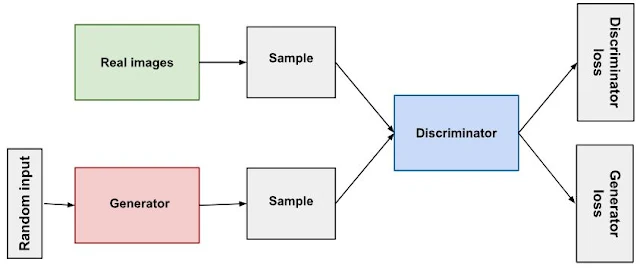Generative Adversarial Networks (GANs)
In the ever-evolving landscape of artificial intelligence, one concept that has gained significant attention is Generative Adversarial Networks, or GANs for short. But what exactly are GANs, and how do they work? Let's break it down in simple terms.
At its core, a Generative Adversarial Network consists of two neural networks – the generator and the discriminator – locked in a game-like competition. The generator's job is to create realistic-looking data, such as images, while the discriminator's task is to distinguish between real data and the fake data generated by the generator.
Here's how Generative Adversarial Networks (GANs) work
 |
| Source: Google for Developers |
- The generator starts by generating random data, such as images of faces or handwritten digits.
- The discriminator then evaluates these generated images, trying to differentiate between real images and fake ones.
- As the discriminator gets better at distinguishing between real and fake images, the generator adjusts its parameters to produce more realistic-looking images.
- This back-and-forth process continues until the generator is able to create images that are indistinguishable from real ones, fooling the discriminator.
- The genius of GANs lies in their ability to learn from each other through this adversarial process. As the generator gets better at creating realistic data, the discriminator is forced to become more discerning, leading to continuous improvement on both fronts.
But what are GANs used for?
Image Generation: GANs have been used to generate photorealistic images of everything from human faces to landscapes, revolutionizing fields like computer graphics and art generation.
Data Augmentation: In machine learning, GANs can be used to augment training data, generating synthetic samples to supplement limited datasets and improve model performance.
Anomaly Detection: GANs can be trained to learn the distribution of normal data, making them effective tools for detecting anomalies or outliers in datasets.
Image-to-Image Translation: GANs can also be used for tasks like image-to-image translation, where they learn to convert images from one domain to another, such as turning sketches into realistic images or changing the season in a landscape photo.
Drug Discovery: In the field of pharmaceuticals, GANs are being used to generate novel molecular structures with desired properties, accelerating the drug discovery process.
Future Prospects of GAN
Ethical Considerations: As GANs become more advanced, ethical considerations surrounding issues like bias, fairness, and privacy become increasingly important.
Continued Innovation: Ongoing research in GANs is focused on improving stability, scalability, and efficiency, as well as exploring new applications in areas like drug discovery and natural language processing.
Generative Adversarial Networks represent a powerful tool in the arsenal of artificial intelligence, enabling the generation of realistic data and driving innovation across various domains. While their potential is vast, it's essential to approach their development and application with careful consideration of ethical implications and potential biases, ensuring that they contribute to positive advancements in technology and society.
Download the Full Seminar Report and PPT on Generative Adversarial Networks (GANs)
Google for Developers has a cool course on Generative Adversarial Networks (GANs) that you should check out if you want to level up your skills. But first, make sure you've completed the Machine Learning Crash Course, either in-person or through self-study. And it's even better if you've got some experience programming with TensorFlow.

0 comments